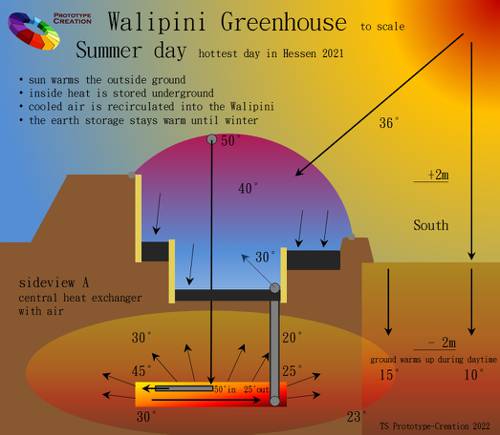
FAQ About Indoor Plant Root Zone Heating Solutions

What are indoor plant root zone heating solutions?
Indoor plant root zone heating solutions are methods used to maintain optimal temperatures for the roots of indoor plants. These solutions ensure that the soil temperature remains within a range that promotes healthy root growth and overall plant health. Common solutions include heat mats, heating cables, and warm air circulation systems.

Why is maintaining root zone temperature important for indoor plants?
Maintaining the right root zone temperature is crucial because roots are sensitive to temperature changes. Optimal root temperatures promote efficient nutrient uptake, prevent root diseases, reduce plant stress, and encourage vigorous growth. Cold roots can lead to nutrient deficiencies and growth stagnation, while excessive heat can damage root cells.

How does a heat mat work for indoor plants?
A heat mat is a flat, electrical device that gently warms the base of plant containers by creating a stable temperature environment. It generates warmth that seeps into the potting mix, maintaining an even temperature that is beneficial for root development, especially during colder months.

What are heating cables and how are they used for root heating?
Heating cables are flexible, electric cables that can be laid in soil or beneath trays to maintain desired soil temperatures. They are often used in propagators or greenhouses but also serve in indoor settings. The cables distribute heat evenly across the soil area, ensuring the root zone is kept at an optimal temperature to facilitate healthy growth.

Can heat lamps be used to warm the root zone of indoor plants?
Heat lamps can provide additional warmth, but they are generally used to increase air temperature rather than specifically heating the root zone. Root zone heating typically requires direct contact, so heat mats or cables are preferred solutions for reaching and maintaining soil temperatures effectively.

Are there any DIY methods for root zone heating?
Yes, DIY methods for root zone heating include using household items like water bottles filled with warm water placed around plant pots, insulating plant pots with materials like bubble wrap, or placing plants on top of a refrigerator or appliance that emits warmth. However, these methods may not always provide consistent temperature control compared to dedicated heating products.

What temperature is considered optimal for the root zone of most indoor plants?
The optimal root zone temperature for most indoor plants typically ranges from 18°C to 24°C (65°F to 75°F). Maintaining temperatures within this range ensures effective nutrient uptake and supports healthy root development and plant growth.

How can root zone heating benefit seed germination?
Root zone heating significantly benefits seed germination by providing a stable and warm environment that encourages seeds to sprout. Many seeds require warmth to break dormancy and begin the germination process, which is why consistent heat from root zone solutions is advantageous.

Can root zone heating help prevent diseases in indoor plants?
Yes, maintaining an optimal root zone temperature can prevent certain diseases by minimizing stress on the plant's roots. Cold and damp conditions can encourage fungal infections and root rot; hence, consistent warmth reduces such risks.

What are the potential drawbacks of using root zone heating solutions?
Potential drawbacks include the risk of overheating roots if not monitored properly, leading to root damage or death. Additionally, some heating systems might increase electricity consumption. Therefore, it is vital to choose a solution with a thermostat or temperature control feature.

Are root heating mats or cables safe to use indoors?
Yes, root heating mats and cables are safe for indoor use when used according to their instructions. Most commercially available products are designed to be energy-efficient and feature various safety standards, including waterproof properties and overheat protection.

Do all indoor plants need root zone heating?
Not all indoor plants need root zone heating. Plants originating from tropical or warm climates, such as orchids and succulents, may benefit more from additional root warmth, especially in cooler environments. In contrast, plants that thrive in cooler climates might not require extra heating.

How can I monitor the root zone temperature of my indoor plants?
Monitoring root zone temperature can be done using soil thermometers or temperature probes inserted into the soil. Digital temperature controllers connected to heating mats and cables also offer a convenient way to maintain and monitor the desired temperatures accurately.

Can root zone heating improve plant growth during winter months?
Yes, root zone heating can significantly enhance plant growth in winter months by counteracting cooler indoor temperatures. It ensures that plant roots remain active and can continue absorbing nutrients efficiently, leading to sustained growth even in low-light and cooler conditions.

What is the difference between bottom heating and ambient air heating for plants?
Bottom heating specifically targets the root zone by warming the soil directly, promoting efficient nutrient uptake and root growth. Ambient air heating, on the other hand, raises the air temperature around the plants, which may indirectly warm the roots but is generally less efficient in targeting and maintaining soil temperatures.

How does root zone heating relate to indoor gardening and hydroponics?
In indoor gardening and hydroponics, maintaining the right root temperature is crucial for optimal plant health and growth. Hydroponic systems often utilize heating mats or water heaters to ensure that the nutrient solution remains at an ideal temperature for root uptake.

Do root zone heating solutions consume much electricity?
Root zone heating solutions are generally not very energy-intensive, especially those designed for household use. Most heat mats and cables have efficient energy consumption models, though usage time and specific power requirements can vary. It's advisable to use models with energy-saving features where possible.

Can root zone heating be combined with other plant care techniques?
Yes, root zone heating can be combined with other plant care techniques like controlled watering, using grow lights, and maintaining proper humidity levels to optimize plant health. Integrating these methods helps create an ideal growing environment tailored to the needs of specific plant varieties.

Is it possible to overheat the root zone of a plant?
Yes, overheating the root zone can occur if the heating solutions are not properly monitored or controlled. Excessively high temperatures can damage root cells, leading to stress or plant death, hence the importance of using thermostats or temperature controllers with heating solutions.

What are signs that my plant might benefit from root zone heating?
Signs that a plant may benefit from root zone heating include slow growth, yellowing leaves, wilting, or signs of nutrient deficiencies despite proper fertilization. These can often result from cold root zones where the plant is unable to efficiently uptake water and nutrients.
